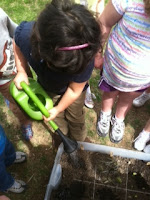Beautiful Butterflies!
In honor of spring, Earth Day, and our study of nonfiction reading and writing, we are learning all about butterflies. Our caterpillars arrived Friday, April 20th. Upon arrival, we began learning about the life cycle of a butterfly. We read a poster about The Life Cycle of the Painted Lady Butterfly that had features of nonfiction that we have been learning about like a heading, photographs, and labels!
Over the weekend, most of our caterpillars finished their transition into their chrysalises, except for one. This morning we had the opportunity to watch as our last caterpillar transitioned! We were concerned about the butterflies having enough space when they emerged, so we moved the chrysalises to these houses with little windows.
We are eagerly awaiting their emergence as fully grown, adult butterflies. We have learned that this usually takes 7-10 days. While we wait, we will be reading more nonfiction texts about butterflies. We will also be making a math connection by adding links to a chain that will help us keep track of how long our butterflies are taking to transform!
The Release!
After 10 days, all of our butterflies had emerged from each chrysalis, and were ready to be set free. Here are pictures from their release:


















































